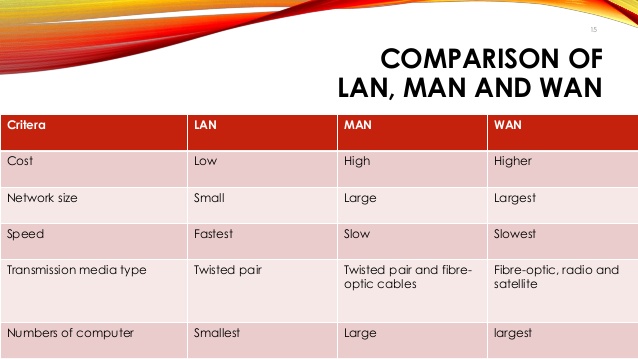Classification of Network:
Networks usually are classified as a:
1.Local Area Network (LAN).
2.Metropolitan Area Network (MAN).
3.Wide Area Network (WAN).
The main differentiation among these classifications is their area of coverage (distinguish by the geographical area each network serves).
Local Area Network (LAN)

A local area network (LAN) is a network that connects computers and devices in a limited geographical area.

A metropolitan area network (MAN) is a high-speed network that connects local area networks (LANs) in a metropolitan area.

A local area network (LAN) is a network that connects computers and devices in a limited geographical area.
Main characteristics of LAN:
1.Areas of coverage: LANs located within the same building (closely
positioned group of buildings) such as a home, school computer
laboratory, office building.
2.Distance: LANs span (cover) distance less than a mile.
3.Ownership: LANs are owned and operated by individual organizations.
Metropolitan Area Network (MAN)
2.Distance: LANs span (cover) distance less than a mile.
3.Ownership: LANs are owned and operated by individual organizations.
Metropolitan Area Network (MAN)

A metropolitan area network (MAN) is a high-speed network that connects local area networks (LANs) in a metropolitan area.
Main characteristics of MAN:
1.Areas
of coverage: MANs connect various locations such as campuses, offices,
and government, that are frequently used as links between buildings.
2.Distance: MANs span (cover) distance up to 100 miles (161 km).
3.Ownership: MANs are owned by a group of users who jointly own and operate the network.
2.Distance: MANs span (cover) distance up to 100 miles (161 km).
3.Ownership: MANs are owned by a group of users who jointly own and operate the network.
Wide Area Network (WAN)


A wide area network (WAN) is a network that covers a large geographical area.
Main characteristics of WAN:
Main characteristics of WAN:
1.Areas of coverage: WANs located within a countryside and worldwide
networks, (such as a city, country, or the world) using a
communications channel that combines many types of media such as
telephone lines, cables and radio waves. The Internet is the world’s
largest WAN.
2.Distance: WANs span (cover) distance greater than 100 miles.
3.Ownership: WANs have no ownership.
2.Distance: WANs span (cover) distance greater than 100 miles.
3.Ownership: WANs have no ownership.
Comparison between LAN, MAN AND WAN


Review of LAN, MAN AND WAN

